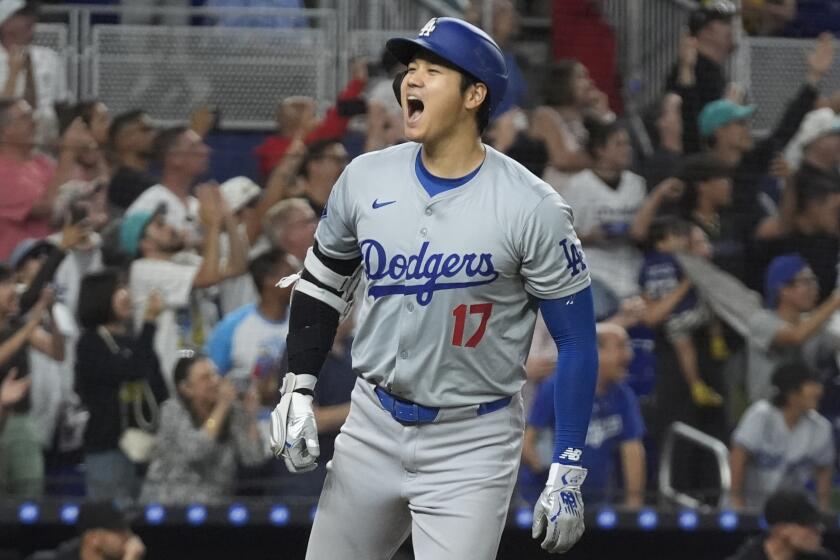Column: Coaches thought this was going to be a crazy Pac-12 season, and they were right

From the first day Chris Petersen took over as football coach at Washington, the question he heard most often was: When are you going to beat Oregon?
The Huskies had lost 12 straight to their Pacific Northwest rival before ending the streak in decisive fashion with 70-21 victory in Eugene last week.
“I’ll tell you what,” said Petersen, now in his third season in Seattle. “I’m glad I don’t have to answer that question anymore.”
Besides exorcising a few demons, the win cemented Washington’s place in the top 5 of national polls and confirmed that, in the Pac-12 Conference, this is a season turned upside-down.
Oregon, Stanford, USC and UCLA are struggling at the midpoint, while Washington State and Arizona State have joined Washington high in the standings.
Each week feels like a roll of the dice with underdogs defeating ranked opponents.
“This is a unique time,” California Coach Sonny Dykes said. “I know talking to the coaches … all us knew how the league was going to be this year.”
Unique, perhaps, and wildly entertaining. But parity has also been potentially damaging, reputation-wise, in a college football environment dominated by the Southeastern Conference and a resurgent Big Ten.
“I think it’s really bad for the league when it comes to getting teams in the playoff and the potential of getting two teams in the playoff,” Dykes said.
The national polls support his argument, but let’s start with the fun part.
Last weekend, Oregon State upset California in overtime and USC eked out a fourth-quarter victory over favored Colorado. The week before, Cal defeated nationally ranked Utah with a goal-line stand in the final seconds.
“If you’re within the conference and you’re winning some of those games, you like it,” Colorado Coach Mike MacIntyre said.
Choose your theory as to why the Pac-12 is so unpredictable.
Geography might play a role. All the schools are bunched in and around California, a recruiting hotbed with enough young players to stock pretty much every roster.
It’s a little different for the rest of the Power Five conferences, dividing up recruits in the other talent centers of Texas and Florida. Programs at the bottom of those leagues can get left out.
“Just another week in the Pac-12,” USC Coach Clay Helton mused. “Having to deal with great athletes.”
Weather might also be a factor in states where teams can afford to play wide-open offenses pretty much year-round. As Washington State Coach Mike Leach said: “I think everybody plays incredibly dangerous.”
So it makes a difference that three of the traditional powers — USC, Oregon and Stanford — started the season with new quarterbacks. When those guys stumbled out of the gate, teams with more-experienced passers were ready to fill the void.
Which leads to the downside.
After missing out on the four-team College Football Playoff last season, the Pac-12 has been eating its own this fall.
Three ranked teams have lost to unranked conference opponents in the past two weekends. This week marks the first time since 1999 that Stanford, Oregon or USC is not in the Associated Press top 25.
Only undefeated Washington (6-0), with quarterback Jake Browning now a part of the Heisman Trophy conversation, appears to have a credible shot at reaching the final four.
“When you watch them, there are no holes,” Stanford Coach David Shaw said. “There are no weak points.”
The same cannot be said for everyone else. The Pac-12 stands third or fourth in most of the conference power rankings and has only one other team — No. 21 Utah — in the Top 25.
Dykes wonders why the Pac-12 plays nine conference games instead of eight, like the SEC or Atlantic Coast Conference. The added date might not seem like much, but it represents one less chance to schedule a softer opponent, one more chance to suffer an upset.
“It really hurts,” Dykes said. “I think you have to look at the SEC model.”
The Big 12 also plays nine games and has struggled. But so does the Big Ten, and that hasn’t stopped No. 2 Ohio State, No. 4 Michigan, No. 8 Wisconsin or No. 10 Nebraska.
As the season progresses, MacIntyre hopes the playoff selection committee will take into account he considers to be an exceptional level of competition — top-to-bottom — in the Pac-12.
Leach, whose Washington State team has rebounded from two early losses, views the situation from another angle.
“I don’t even think about that,” he said. “I think about winning one game at a time.”
More to Read
Go beyond the scoreboard
Get the latest on L.A.'s teams in the daily Sports Report newsletter.
You may occasionally receive promotional content from the Los Angeles Times.











